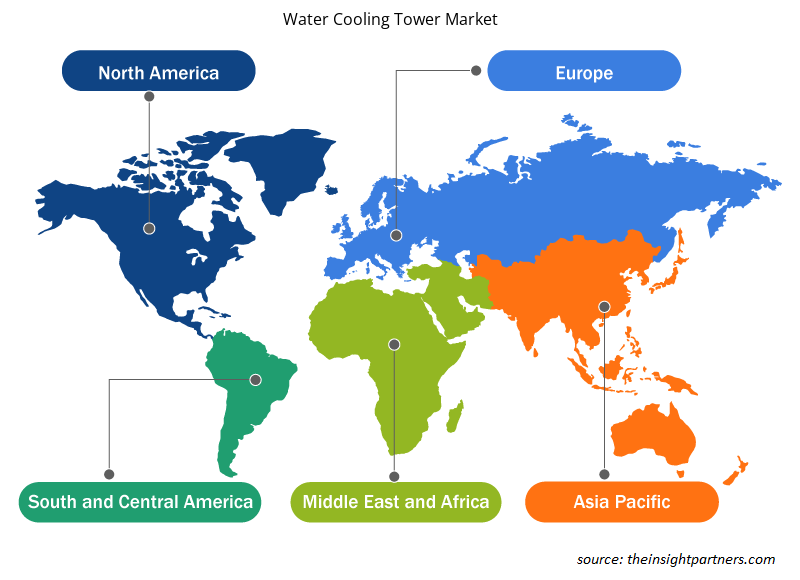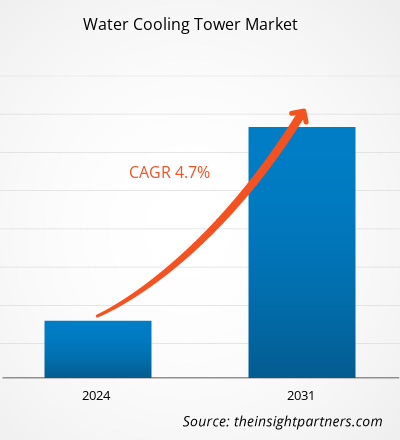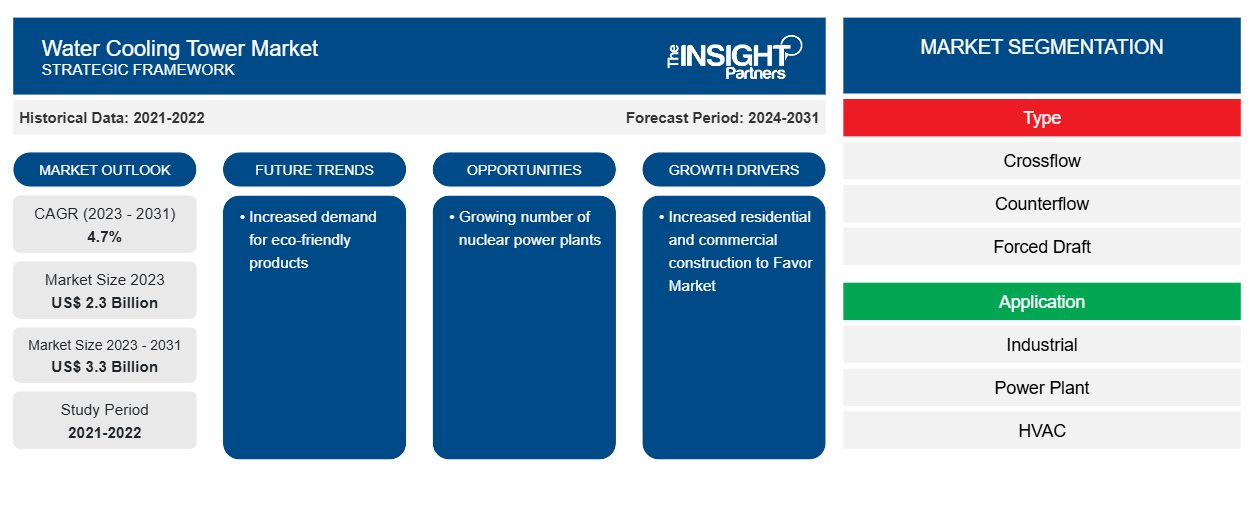Der Markt für Wasserkühltürme soll von 2,3 Milliarden US-Dollar im Jahr 2023 auf 3,3 Milliarden US-Dollar im Jahr 2031 anwachsen. Für den Zeitraum 2023–2031 wird ein durchschnittliches jährliches Wachstum von 4,7 % erwartet. Angesichts der wachsenden Sorge um Nachhaltigkeit und die Reduzierung des CO2-Fußabdrucks ist die Nachfrage nach umweltfreundlichen Produkten zur Wasserturmkühlung gestiegen. Daher dürfte eine erhöhte Nachhaltigkeit ein wichtiger Trend auf dem Markt bleiben.
Marktanalyse für Wasserkühltürme
Die Nachfrage nach Wasserkühltürmen ist im Energiesektor gestiegen. Da der Energiebedarf wächst, sind in den letzten Jahren die Ausgaben für den Bau von Kraftwerken und damit die Gesamtzahl der Kraftwerke gestiegen. Laut den von der US-Regierung veröffentlichten Daten konzentriert sich das Land beispielsweise darauf, im Jahr 2024 55 % mehr Kraftwerke zu bauen als im Jahr 2023. Solche Bauausgaben im Energiesektor treiben die Nachfrage auf dem Markt für Wasserkühltürme an.
Marktübersicht für Wasserkühltürme
Im Jahr 2023 hatte Nordamerika einen beachtlichen Marktanteil am globalen Markt für Wasserkühltürme. Länder wie die USA und Kanada sind führend auf dem nordamerikanischen Markt für Wasserkühltürme. Einer der Faktoren, die den Markt antreiben, ist das starke industrielle Wachstum. Rechenzentren benötigen ein leistungsstarkes Kühlsystem, um die Betriebseffizienz aufrechtzuerhalten. Daher sind viele Rechenzentren mit Kühltürmen ausgestattet, um die Temperatur aufrechtzuerhalten. Kühltürme in den Rechenzentren verwenden Luft und Wasser, um die Wärme der Rechenzentren zu übertragen. Diese Kühlsysteme sind effizienter als herkömmliche Luftkühlungsmethoden , haben geringere Betriebskosten und sind flexibler. Laut den Daten von Cloudscene gibt es in den USA etwa 5400 Rechenzentren. Aufgrund der großen Anzahl von Rechenzentren ist die Nachfrage nach Wasserkühltürmen in den letzten Jahren gestiegen.
Passen Sie diesen Bericht Ihren Anforderungen an
Sie erhalten kostenlos individuelle Anpassungen an jedem Bericht, einschließlich Teilen dieses Berichts oder einer Analyse auf Länderebene, eines Excel-Datenpakets sowie tolle Angebote und Rabatte für Start-ups und Universitäten.
-
Holen Sie sich die wichtigsten Markttrends aus diesem Bericht.Dieses KOSTENLOSE Beispiel umfasst eine Datenanalyse von Markttrends bis hin zu Schätzungen und Prognosen.
Markttreiber und Chancen für Wasserkühltürme
Erhöhter Wohnungs- und Gewerbebau begünstigt den Markt
Aufgrund der starken Urbanisierung und Industrialisierung wächst der gewerbliche und Wohnungsbau rasant. Etwa 93 % aller Gebäude sind Wohn- und Gewerbebauten; außerdem sind etwa 85 % der gesamten Gebäudefläche für Wohn- und Gewerbebauten vorgesehen. Mit dieser stärkeren Durchdringung des Wohn- und Gewerbebaus ist die Nachfrage nach HLK-Systemen gestiegen, was letztlich den Markt für Wasserkühltürme ankurbelt.
Wachsende Zahl von Atomkraftwerken
Da der Energiebedarf steigt, steigt auch die Nachfrage nach Kernkraftwerken. Aufgrund des gestiegenen Bewusstseins für Kohlenstoffemissionen rückten Kernkraftwerke außerdem stärker in den Fokus, da sie effizienter und effektiver sind. Laut den vom Nuclear Energy Institute veröffentlichten Daten werden in den USA durch die Nutzung von Kernkraftwerken etwa 471 Millionen Tonnen Kohlenstoff vermieden. Darüber hinaus tragen Kernenergiequellen derzeit 10 % zur weltweiten Elektrizitätserzeugung bei. Daher erhöhen Regierungen auf der ganzen Welt den Beitrag von Kernkraftwerken, indem sie mehr Kraftwerke bauen. Laut den von der World Nuclear Association veröffentlichten Daten befinden sich beispielsweise 60 Kernkraftwerke im Bau . Die erhöhte Nachfrage nach Kernkraftwerken dürfte also in den kommenden Jahren erhebliche Umsatzmöglichkeiten generieren.
Segmentierungsanalyse des Marktberichts für Wasserkühltürme
Wichtige Segmente, die zur Ableitung der Marktanalyse für Wasserkühltürme beigetragen haben, sind Typ und Anwendung.
- Basierend auf dem Typ ist der Markt für Wasserkühltürme in Querstrom, Gegenstrom, Druckzug, Saugzug und andere unterteilt. Das Querstromsegment hatte im Jahr 2023 einen größeren Marktanteil.
- Nach Anwendung ist der Markt in Industrie, Kraftwerke und HLK unterteilt. Das Industriesegment hielt im Jahr 2023 einen bemerkenswerten Marktanteil.
Marktanteilsanalyse für Wasserkühltürme nach Geografie
Der geografische Umfang des Marktberichts für Wasserkühltürme ist hauptsächlich in fünf Regionen unterteilt: Nordamerika, Asien-Pazifik, Europa, Naher Osten und Afrika sowie Süd- und Mittelamerika.
Der asiatisch-pazifische Raum hatte den größten Marktanteil auf dem globalen Markt für Wasserkühltürme. Länder wie China, Indien, Indonesien und die Philippinen verzeichnen ein beachtliches Wachstum. Dieses Wachstum führt zu einem erhöhten Energiebedarf, da der Industriesektor schnell wächst. Darüber hinaus ist aufgrund der Urbanisierung die Nachfrage im Wohn- und Gewerbesektor gestiegen. Mit diesem Wachstum in den Bereichen Bau, Industrie und Energie stieg die Nachfrage nach kostengünstigen Kühlsystemen, was letztlich den Markt für Wasserkühltürme ankurbelte.
Regionale Einblicke in den Markt für Wasserkühltürme
Die regionalen Trends und Faktoren, die den Markt für Wasserkühltürme im Prognosezeitraum beeinflussen, wurden von den Analysten von Insight Partners ausführlich erläutert. In diesem Abschnitt werden auch die Marktsegmente und die Geografie von Wasserkühltürmen in Nordamerika, Europa, im asiatisch-pazifischen Raum, im Nahen Osten und Afrika sowie in Süd- und Mittelamerika erörtert.

- Erhalten Sie regionale Daten zum Markt für Wasserkühltürme
Umfang des Marktberichts über Wasserkühltürme
| Berichtsattribut | Details |
|---|---|
| Marktgröße im Jahr 2023 | 2,3 Milliarden US-Dollar |
| Marktgröße bis 2031 | 3,3 Milliarden US-Dollar |
| Globale CAGR (2023 - 2031) | 4,7 % |
| Historische Daten | 2021-2022 |
| Prognosezeitraum | 2024–2031 |
| Abgedeckte Segmente |
Nach Typ
|
| Abgedeckte Regionen und Länder |
Nordamerika
|
| Marktführer und wichtige Unternehmensprofile |
|
Marktteilnehmerdichte: Der Einfluss auf die Geschäftsdynamik
Der Markt für Wasserkühltürme wächst rasant, angetrieben durch die steigende Nachfrage der Endnutzer aufgrund von Faktoren wie sich entwickelnden Verbraucherpräferenzen, technologischen Fortschritten und einem größeren Bewusstsein für die Vorteile des Produkts. Mit steigender Nachfrage erweitern Unternehmen ihr Angebot, entwickeln Innovationen, um die Bedürfnisse der Verbraucher zu erfüllen, und nutzen neue Trends, was das Marktwachstum weiter ankurbelt.
Die Marktteilnehmerdichte bezieht sich auf die Verteilung der Firmen oder Unternehmen, die in einem bestimmten Markt oder einer bestimmten Branche tätig sind. Sie gibt an, wie viele Wettbewerber (Marktteilnehmer) in einem bestimmten Marktraum im Verhältnis zu seiner Größe oder seinem gesamten Marktwert präsent sind.
Die wichtigsten auf dem Markt für Wasserkühltürme tätigen Unternehmen sind:
- Babcock & Wilcox Enterprises
- Einschl.
- Baltimore Aircoil-Unternehmen
- Glockenkühltürme
- Delta Kühltürme
- Einschl.
Haftungsausschluss : Die oben aufgeführten Unternehmen sind nicht in einer bestimmten Reihenfolge aufgeführt.

- Überblick über die wichtigsten Akteure auf dem Markt für Wasserkühltürme
Neuigkeiten und aktuelle Entwicklungen zum Wasserkühlturmmarkt
Der Markt für Wasserkühltürme wird durch die Erhebung qualitativer und quantitativer Daten nach Primär- und Sekundärforschung bewertet, die wichtige Unternehmensveröffentlichungen, Verbandsdaten und Datenbanken umfasst. Nachfolgend sind einige der Entwicklungen auf dem Markt für Wasserkühltürme aufgeführt:
- Baltimore Aircoil Company (BAC) gibt die Veröffentlichung seines neuen adiabatischen Kühlers der TrilliumSeries bekannt. Dieser adiabatische Kühler ist ideal für Anwendungen, die eine Kombination aus Energieeffizienz und begrenztem Wasserverbrauch erfordern. Das innovative Design von BAC maximiert sowohl die Wasser- als auch die Energieeffizienz und minimiert letztlich die Kosten. Darüber hinaus ist der Kühler der TrilliumSeries so konzipiert, dass die Installation und laufende Wartung einfach sind. (Quelle: Baltimore Aircoil Company, Pressemitteilung, Februar 2022)
- Tower Tech, der führende Hersteller von Kühltürmen, ist stolz darauf, seine Kühlturmlinie mit korrosionsbeständiger StormStrong Fiber Reinforced Polymer (FRP)-Technologie vorzustellen. Die StormStrong-Kühltürme sind in der Lage, orkanartigen Winden, Erdbeben und wetterbedingten Belastungen mit minimalen bis keinen Schäden standzuhalten. (Quelle: Tower Tech, Pressemitteilung, September 2022)
Marktbericht zu Wasserkühltürmen – Abdeckung und Ergebnisse
Der Bericht „Marktgröße und Prognose für Wasserkühltürme (2021–2031)“ bietet eine detaillierte Analyse des Marktes, die die folgenden Bereiche abdeckt:
- Marktgröße und Prognose für Wasserkühltürme auf globaler, regionaler und Länderebene für alle wichtigen Marktsegmente, die im Rahmen des Berichts abgedeckt sind
- Markttrends für Wasserkühltürme sowie Marktdynamik wie Treiber, Beschränkungen und wichtige Chancen
- Detaillierte PEST- und SWOT-Analyse
- Marktanalyse für Wasserkühltürme mit Blick auf wichtige Markttrends, globale und regionale Rahmenbedingungen, wichtige Akteure, Vorschriften und aktuelle Marktentwicklungen
- Branchenlandschaft und Wettbewerbsanalyse, die die Marktkonzentration, Heatmap-Analyse, prominente Akteure und aktuelle Entwicklungen auf dem Markt für Wasserkühltürme umfasst
- Detaillierte Firmenprofile
- Historische Analyse (2 Jahre), Basisjahr, Prognose (7 Jahre) mit CAGR
- PEST- und SWOT-Analyse
- Marktgröße Wert/Volumen – Global, Regional, Land
- Branchen- und Wettbewerbslandschaft
- Excel-Datensatz
Aktuelle Berichte
Verwandte Berichte
Erfahrungsberichte
Grund zum Kauf
- Fundierte Entscheidungsfindung
- Marktdynamik verstehen
- Wettbewerbsanalyse
- Kundeneinblicke
- Marktprognosen
- Risikominimierung
- Strategische Planung
- Investitionsbegründung
- Identifizierung neuer Märkte
- Verbesserung von Marketingstrategien
- Steigerung der Betriebseffizienz
- Anpassung an regulatorische Trends























 Kostenlose Probe anfordern für - Markt für Wasserkühltürme
Kostenlose Probe anfordern für - Markt für Wasserkühltürme